|
|
|
Sort Order |
|
|
|
Items / Page
|
|
|
|
|
|
|
| Srl | Item |
| 1 |
ID:
132358


|
|
|
|
|
| Publication |
2014.
|
| Summary/Abstract |
How and to what extent is the preventive use of force becoming the future of foreign policy for states around the world? We explore the spread of preventive logic to increasing numbers of states and examine the degree to which an international norm toward preventive self-defense is cascading in the international system. Through content and comparative case study analysis, we investigate leaders' rhetoric and security policies concerning what we theorize is the key indicator of a country's emulation of the United States: assertion of the right to the unilateral, preventive use of force outside of its borders. Our evidence indicates that there has been a shift away from the established international norm-which considers the use of preventive force illegal and illegitimate-toward growing acceptance of unilateral preventive strategies, a shift largely propelled by the precedents set by the United States in the war in Iraq and its use of unmanned aerial vehicles (UAVs or drones) in the global war on terror. Our findings also reveal that some states are applying the strategy of preventive self-defense beyond the use of UAVs for targeted killings to the extreme contingency plan for nuclear war. We conclude by discussing possibilities for further research and considering the implications of this phenomenon.
|
|
|
|
|
|
|
|
|
|
|
|
|
|
|
|
| 2 |
ID:
133289
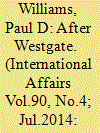

|
|
|
|
|
| Publication |
2014.
|
| Summary/Abstract |
The attack on the Westgate Mall in Nairobi, Kenya, in September 2013 intensified international scrutiny of the war against Harakat Al-Shabaab Mujahideen (Movement of the Warrior Youth). This article analyses the current state of affairs with reference to the three principal sets of actors in this war: Al-Shabaab, the African Union Mission in Somalia (AMISOM) and its international partners, and the various actors currently involved in building the Somali Federal Government's security forces. It argues that although the newly reconfigured Al-Shabaab poses a major tactical threat in Somalia and across the wider Horn of Africa, the movement is becoming a less important actor in Somalia's national politics. As Al-Shabaab loses territory and its popularity among Somalis continues to dwindle, other clan- and region-based actors will become more salient as national debates over federalism, the decentralization of governance mechanisms beyond Mogadishu and the place of clannism will occupy centre stage. As a consequence, AMISOM's principal roles should gradually shift from degrading Al-Shabaab towards a broader stabilization agenda: encouraging a national consensus over how to build effective governance structures; developing an effective set of Somali National Security Forces; and ensuring that the Federal Government delivers services and effective governance to its citizens, especially beyond Mogadishu in the settlements recently captured from Al-Shabaab. As it stands, however, AMISOM is not prepared to carry out these activities. More worryingly, nor is the Somali Federal Government.
|
|
|
|
|
|
|
|
|
|
|
|
|
|
|
|
| 3 |
ID:
131427
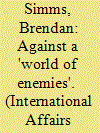

|
|
|
|
|
| Publication |
2014.
|
| Summary/Abstract |
Adolf Hitler's experiences during the First World War have been much discussed, with historians tending to concentrate on his involvement in the fighting and the operational lessons he later claimed to draw. Much less has been written about the impact of the war on his world view, though recent work has tended to suggest that his paranoid anti-Semitism was not yet visible during the conflict. Drawing on this latest research, but also on newly discovered sources and previously underused material, the author shows that Hitler's main preoccupation during the war and its immediate aftermath was the overwhelming power of Great Britain and its American ally. He associated these two powers with the alleged international Jewish economic conspiracy that had crushed the German empire. Hitler's anti-Semitism thus originated in an anti-capitalist, rather than anti-communist, discourse. He blamed Britain and the US for the rigours of the Versailles peace settlement, a moment which was far more politically formative for him than the experience of defeat itself. His encounter with American soldiers in the summer of 1918 also marked his first engagement with the global power of the United States and the start of a belief in the demographic weakness of the German empire which inspired his plans for Lebensraum in the east.
|
|
|
|
|
|
|
|
|
|
|
|
|
|
|
|
| 4 |
ID:
132298
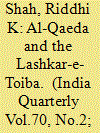

|
|
|
|
|
| Publication |
2014.
|
| Summary/Abstract |
Study of ideology is one of the most important domains of consideration for a successful counter-terrorism strategy. It is necessary to know and understand the ideology of a terrorist outfit coupled with the ongoing evolution at the same, its chief ideologues and its target audiences in order to provide an alternative ideology or in other words to win the 'hearts and the minds' of the people. This article traces the mounting similitude in the discourse and the actions of Lashkar-e-Taiba and the ideology of Al-Qaeda. The article begins with a brief depiction of the debate on the 'end of ideology' before proceeding on to an examination of Al-Qaeda's ideology. In the next section, LeT's discourse and actions from 1990 to 2010 are scrutinised followed by an analysis that attempts to draw out parallels between the ideologies of the two terrorist organisations. In the last section, the conclusion raises several pertinent points for the consideration of counter-terrorist specialists and policy makers.
|
|
|
|
|
|
|
|
|
|
|
|
|
|
|
|
| 5 |
ID:
128738
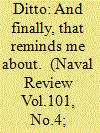

|
|
|
|
|
| Publication |
2013.
|
| Summary/Abstract |
Since I now live in the Gulf, it was a happy coincidence that found me in Portsmouth on 16th July 2013 and therefore able to attend the Centenary Party; and what a splendid affairs it was. I must have taken much work to prepare and I'm sure members will join me in thanking everyone involved.
|
|
|
|
|
|
|
|
|
|
|
|
|
|
|
|
| 6 |
ID:
132808
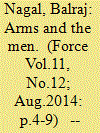

|
|
|
|
|
| Publication |
2014.
|
| Summary/Abstract |
The five pre-1998 nuclear powers have matured their Nuclear Command and Control Structures, and Nuclear Forces Structures (NFS) over a period ranging from 70 years for the US to 50 years for China.
The Cold War arms race created thousands of systems for command and control or functioning of military forces. The C4ISR systems deployed or under development provide 24 hours continuous surveillance of each other's areas/offensive weapons, detect movement of strategic systems or change of deployment patterns and allied/linked systems. The command and control of these powers are well developed, with state-of-the-art electronic systems to function under NBC conditions. The command centres are located in deep underground hardened shelters, capable of withstanding nuclear attacks, functioning 24x7.
|
|
|
|
|
|
|
|
|
|
|
|
|
|
|
|
| 7 |
ID:
134047
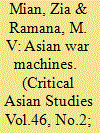

|
|
|
|
|
| Publication |
2014.
|
| Summary/Abstract |
The South Asian security landscape is increasingly dominated by a complex four-way dynamic between India, Pakistan, China, and the United States. The stresses and strains of the relationships between these states directly affect the prospects for peace and prosperity for almost half of humanity. This article describes some of the military contours of this landscape, with a focus on strategic postures, weapon acquisitions, and the role of nuclear weapons. It maps the India-Pakistan arms race over the past decade, the economic constraints on the two states, the role of China and the United States as weapons suppliers, and the risk and consequences for nuclear war. The authors then look at India's relationship with China, which is marked by both cooperation and competition, and the rise of China as a close military, political, and economic ally of Pakistan. While the United States has had long-standing cooperative relationships with both India and Pakistan, these relationships have been undergoing major shifts over the last two decades. U.S. concerns about China's increasing military and economic power have also intensified over this period as well. Of particular significance has been the effort to create a U.S.-India strategic partnership to balance and contain a rising China, which may become a central feature of the emerging global order. This article also offers a brief overview of what is publicly known about the nuclear arsenals of the four countries, ongoing production of weapons-usable fissile materials in Pakistan and India, as well as the race to build longer-range missiles.
|
|
|
|
|
|
|
|
|
|
|
|
|
|
|
|
| 8 |
ID:
133804
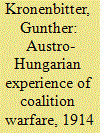

|
|
|
|
|
| Publication |
2014.
|
| Summary/Abstract |
Austria-Hungary's experience of Germany's junior partner was fraught with misunderstandings and a failure to devise a coherent common strategy
While the Anglo-French experience of coalition warfare during the First World War has been the subject of many English-language volumes, Austria-Hungary's relationship with Germany - its senior partner within the Triple Alliance - has been underexplored. In this article, Günther Kronenbitter analyses the uneasy dynamics of this alliance, tracing it through the two countries' wilfully blinkered, thirty-year preparations for a war that eventually came in August 1914, before exploring their increasingly fraught and inadequate efforts to co-ordinate their campaigns and resources - a process marked by resentment and, more importantly, a failure to take a unified strategic approach.
|
|
|
|
|
|
|
|
|
|
|
|
|
|
|
|
| 9 |
ID:
132081


|
|
|
|
|
| Publication |
2014.
|
| Summary/Abstract |
The NATO summit in Wales will be one of the most important since the Cold War ended - the first such summit after what is, undeniably, the end of the post-Cold War era. The goals of transitioning Afghanistan operations, preparing NATO for future challenges, and cementing the transatlantic bond have all been lent urgency by the crisis in Ukraine and the collapse of positive relations with Russia. James Bergeron explores where NATO has been on its twenty-five-year journey through the post-Cold War era and surveys the strategic challenges that the Alliance now confronts.
|
|
|
|
|
|
|
|
|
|
|
|
|
|
|
|
| 10 |
ID:
139181
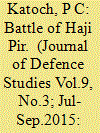

|
|
|
|
|
| Summary/Abstract |
In 1965, Pakistan attempted infiltration into Jammu and Kashmir (J&K), with Operation Gibralter, followed by a planned capture of Akhnoor Bridge under Operation Grand Slam. While Operation Gibraltar was bold from the point of view of multi-directional infiltration, it was largely based on the utopian dream of President Ayub Khan and Foreign Minister Zulfiqar Ali Bhutto, ignoring the ground realities that J&K’s population would not support it. The Indian reaction was swift and included the epic capture of the strategic Haji Pir Pass at a height of 2,637 metres (m) on the formidable Pir Panjal Range that divided the Srinagar valley from the Jammu region. The pass has been a constant source of problems since Pakistan-trained militants have been sneaking into the Kashmir Valley, Poonch and Rajouri districts. Ironically, the Haji Pir Pass, captured through a heroic and daring action, had to be returned to Pakistan under the Tashkent Agreement.
|
|
|
|
|
|
|
|
|
|
|
|
|
|
|
|
| 11 |
ID:
133403
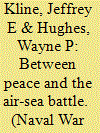

|
|
|
|
|
| Publication |
2012.
|
| Summary/Abstract |
Land-sea wars" have significant maritime dimensions, with command of the sea posited by this study as mattering more than either [land combat] skill or strength. . . . [C]ommand of the sea is a preeminent form of power that determines the outcome of land-sea conflicts.
JOHN ARQUILLA
In a February 2012 article published in the American Interest, General Norton A. Schwartz, Chief of Staffof the U.S. Air Force, and Admiral Jonathan W. Greenert, Chief of Naval Operations, provide solid justification for more closely integrating Air Force and Navy capabilities into an Air-Sea Battle strategy.1 We applaud the Air-Sea Battle component as the most effective means of preparing for the most challenging conflict-full-scale conventional war
|
|
|
|
|
|
|
|
|
|
|
|
|
|
|
|
| 12 |
ID:
108608


|
|
|
| 13 |
ID:
133418
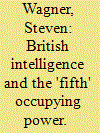

|
|
|
|
|
| Publication |
2014.
|
| Summary/Abstract |
At the end of the Second World War, British intelligence struggled to enforce strict limits imposed on Jewish immigration to Palestine. Holocaust survivors and Jews wishing to escape communism in Eastern Europe flooded the western Zones of occupation in Germany and Austria, while the Zionist movement worked to bring them to Palestine. Illegal immigration to Palestine was the key policy dispute between Britain and the Zionist movement, and a focus for British intelligence. Britain sought both overt and covert means to prevent the boarding of ships at European ports which were destined for Palestine, and even to prevent the entry of Jewish refugees into the American zones. This article highlights Britain's secret intelligence-gathering efforts as well as its covert action aimed to prevent this movement. It highlights a peculiar episode in the 'special relationship' between Britain and the United States, during which cooperation and partnership was lacking. British intelligence promoted a rumour that Soviet agents were using Jewish escape lines to penetrate Western Europe and the Middle East in order to persuade American authorities to prevent the movement of Jewish refugees. Instead, this article argues, American intelligence secretly cooperated with the Zionist organizers of the escape routes so to expose Soviet agents. Britain's attempt at deception backfired, and provided effective cover for the movement of hundreds of thousands of Jews during a critical period. Meanwhile its intelligence had dramatically improved, but policymakers failed to reassess Britain's ability to sustain immigration restrictions and the indefinite detention of tens of thousands of illegal migrants.
|
|
|
|
|
|
|
|
|
|
|
|
|
|
|
|
| 14 |
ID:
132004
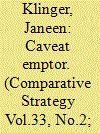

|
|
|
|
|
| Publication |
2014.
|
| Summary/Abstract |
Although intuitively social science has much to contribute to strategy, this article examines the difficulty for strategists doing so. To illustrate the difficulty, the article draws on two social science theories that provided conceptual frameworks for U.S. strategy in the 1960s: deterrence/coercion theory and modernization theory. The article also draws on the cases of Project Camelot in the 1960s and the recent use of human terrain teams to illustrate the difficulty encountered by the military when it tries to use social scientists operationally.
|
|
|
|
|
|
|
|
|
|
|
|
|
|
|
|
| 15 |
ID:
133050
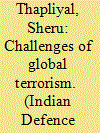

|
|
|
|
|
| Publication |
2014.
|
| Summary/Abstract |
There should be no distinction between a good and a bad terrorist which is what some countries are trying to do. The scourge will consume all unless it is ruthlessly eliminated. Countries sponsoring terrorism might realise that it is like riding a tiger that, one day, they might tall prey to. The biggest worry at these countries which have sulterecl at the hands at terrorists is that Weapons of Mass Destruction may fall into the hands at the terrorists and that catastrophic consequences would tollowi A worldwide integrated approach to tackling terrorism is, therefore, a must.
|
|
|
|
|
|
|
|
|
|
|
|
|
|
|
|
| 16 |
ID:
132813
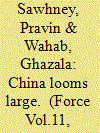

|
|
|
|
|
| Publication |
2014.
|
| Summary/Abstract |
India's national security, especially its defence preparedness against Pakistan and China, with whom it has disputed border, is passing through a disturbing phase. Pakistan continues with cross border terrorism into Jammu and Kashmir, while China infringes upon Indian land and air space from Ladakh to Arunachal Pradesh at will. Both have made a mockery of the military-held lines with India.
Speaking in Parliament during the recent budget session, defence minister Arun Jaitley expressed satisfaction regarding the two disputed borders. According to him, the Indian Army has minimised infiltration across the Line of Control and terrorism in the hinterland with a mix of good anti-infiltration deployment, monitoring and surveillance means, and the fence. Chinese intrusions, he said, are because of differing perception of the disputed border by the two countries.
Do we want better detection and elimination of terrorists in Kashmir, or do we want to compel Pakistan to stop infiltration? If India does not intrude into Chinese land, why should China do this to India regularly?
India seems to have accepted low defence thresholds against both neighbours. This is worrisome. If Pakistan and China are not deterred by India and its military power, especially boots on the ground, will India's two-front war strategy work to compel them? Why is India spending nearly USD 49 billion annually, which excludes defence pensions and nuclear weapons capability, on defence when it appears blunted? Is there a way out for India without going to war with either or both?
India needs a transformation of its national security and defence thinking. It must know that China rather than Pakistan is its irreconcilable adversary, and the disputed border with China is India's singular core concern which impedes India's rise. Once this is grasped, a new approach to policy-making and warfare would emerge. China could be balanced by a political-military methodology, while peace could be made with Pakistan. India's warfare practised so far would alter drastically. With China as the main adversary, India would no longer be preparing to fight the last war better. With more domains like space, cyber, ballistic and cruise missiles, irregular warriors (terrorists) and nuclear weapons added to the conventional combat on land, air and sea, India will need different higher defence organisation and higher strategic organisation from those proposed so far. All this can be done without raising either annual defence allocations or ringing alarm bells in the region.
|
|
|
|
|
|
|
|
|
|
|
|
|
|
|
|
| 17 |
ID:
132215
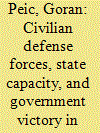

|
|
|
|
|
| Publication |
2014.
|
| Summary/Abstract |
Given the onset of a violent rebellion by an armed non-state group, how do states re-establish intra-state peace and hence fulfill their basic function as providers of internal security? In this article I argue that one way governments perform this core function is by recruiting non-combatants into local self-defense units called civilian defense forces (CDFs). By providing for local security, leveraging their superior local knowledge, and provoking insurgent reprisals against civilians, CDF units facilitate the influx of tactical intelligence as well as isolate insurgents from non-combatant populations physically as well as politically. Consistent with the argument, statistical analyses of two different cross-national data sets of insurgencies from 1944 to 2006 reveal that a state is 53 percent more likely to vanquish a guerrilla threat if the incumbent deploys CDFs. The analyses also cast doubt on a recent claim in the literature that incumbent force mechanization adversely affects the states' ability to counter insurgent threats. Given that CDF deployment is a more easily manipulable variable than most other elements of state power, CDFs appear to be an effective instrument of counterinsurgency deserving of further academic and policy attention.
|
|
|
|
|
|
|
|
|
|
|
|
|
|
|
|
| 18 |
ID:
133402
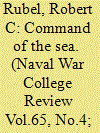

|
|
|
|
|
| Publication |
2012.
|
| Summary/Abstract |
the trade of the world commands the riches of the world and consequently the world itself. For in war . . . the common sense of some and the genius of others sees and properly applies means to ends; and naval strategy, like naval tactics, when boiled down, is simply the proper use of means to attain ends. But in peace, as in idleness, such matters drop out of mind, unless systematic provision is made for keeping them in view.
The last great sea battle occurred in 1944. Since then the world ocean has been open to free navigation by all nations as a matter of American policy. The ability to enforce this policy-or perhaps better said, the absence of serious challenges to this policy-has been in significant part a product of the superiority of the U.S. Navy. Despite a latent and partial challenge during the Cold War by the Soviet navy, since World War II the degree and persistence of U.S. Navy superiority have led most people to take it for granted and have caused the old term "command of the sea" virtually to disappear from the naval lexicon.1 However,
the emergence of a powerful Chinese navy and an associated land-based seadenial force is stimulating a new focus on sea control and overcoming antiaccess/ area-denial efforts. New concepts, such as "AirSea Battle," are being developed and investments made in platforms, weapons, and systems. This activity is critical to American strategic interests and prospects, and it must be informed by an understanding of command of the sea as a foundational concept of sea power. A reconsideration of command of the sea is all the more necessary as political, economic, and technological developments have significantly changed the nature of how sea power influences the dynamics of geopolitical interactions. This article will argue for an extended definition of the term and its renewed application to naval strategy and doctrine.
|
|
|
|
|
|
|
|
|
|
|
|
|
|
|
|
| 19 |
ID:
132325


|
|
|
|
|
| Publication |
2014.
|
| Summary/Abstract |
This article examines compliance with international laws prohibiting the intentional targeting of noncombatants in interstate war, specifically focusing on the role of third-party states in enforcement. We argue that the expectation of third-party coercion, when sufficiently high, can induce war participants to comply with this body of law. We identify the conditions under which combatant states will anticipate a high likelihood of coercion, demonstrating that third-party states are most likely to coerce combatants when they have both the willingness and opportunity to do so. Democratic third parties that value the rule of law and human rights possess the willingness to coerce war participants, while strong allies, trade partners, and intergovernmental organization (IGO) partners with existing ties to the combatant state have the opportunity to engage in coercion by linking combat-ant behavior to the provision of benefits or imposition of costs. Based on this logic, we hypothesize that war combatants who have ratified the Geneva/Hague Conventions prohibiting the intentional targeting of noncombatants during war are more likely to comply with the legal obligations included in those conventions when they interact with relatively strong democratic alliance, trade, and IGO partners. In a series of quantitative tests on a data set of all interstate wars from 1900 to 2003, we find strong statistical and substantive support for the role of third parties in inducing compliance with the law.
|
|
|
|
|
|
|
|
|
|
|
|
|
|
|
|
| 20 |
ID:
133130
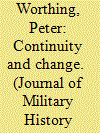

|
|
|
|
|
| Publication |
2014.
|
| Summary/Abstract |
This article analyzes the Chinese Nationalist Army at the tactical level, examining how the Nationalists deployed and employed forces to achieve victory from the earliest battles in 1925 to the first stage of the war against the Japanese in 1937-1938. It argues that certain "core characteristics" of the Nationalist Army shaped its tactics in a way that maximized its strengths and minimized its weaknesses, producing a number of important victories from 1925 to 1930. Importantly, the year 1930 marked a key turning point as new enemies and conditions led the Nationalists away from the successful tactics of the 1920s, contributing to the weaker record of the 1930s.'
|
|
|
|
|
|
|
|
|
|
|
|
|
|
|
|
|
|
|
|
|